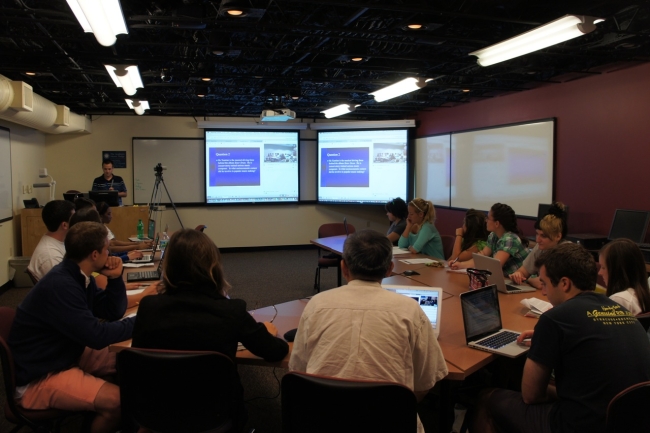You have /5 articles left.
Sign up for a free account or log in.

Students at Rollins College attend a blended course in advanced Chinese.
Associated Colleges of the South
After three years of experimenting with blended learning, leaders of the Associated Colleges of the South feel a movement is growing, but they aren't sure if the push will last.
The association, which consists of 16 liberal arts institutions across 12 Southern states, made blended learning one of its formal programs in the fall of 2011. With support from the Andrew W. Mellon, Robert W. Woodruff and Teagle Foundations, the program has awarded more than $200,000 over the last three years to fund 42 experiments that include flipped classrooms, digital humanities and content from massive open online courses.
The association’s goal, as outlined in a set of upcoming reports, is to create a different kind of model for blended learning -- defined as “computer-mediated instruction that is combined with the interpersonal and interactive pedagogy that distinguishes the ACS institutions.”
In simpler terms, that means a form of blended learning that won’t alienate faculty members who value the defining characteristics of a liberal arts college -- not just the curriculum, but the close student-faculty interaction. While larger universities may pursue blended learning to reduce classroom time, that same idea would be considered anathema at many of the association’s member institutions.
“We’re taking an approach that enhances what we do best, and certainly what we do best are those connections between faculty and students,” said Melanie L. Styers, assistant professor of biology at Birmingham-Southern College. “We like the small classroom... and we’re trying to use blended learning to build on that by engaging our students in even more ways -- as opposed to taking away from how we engage students.”
In a progress report to the Teagle Foundation, the association is frank about the challenges of convincing faculty members that blended learning can work well at liberal arts colleges.
“[M]any faculty regard blended learning with suspicion or even outright distaste,” the report reads. “Yet if blended learning can be described in terms of successful projects that illustrate the ways in which technology can enrich the learning experience and increase what students learn, most faculty members quickly become enthusiastic and thoughtful participants in the conversation.”
Compared to the association’s other initiatives, including programs on diversity, gender studies and sustainability, among others, it is “probably fair to say” that blended learning has been a tougher sell, said Amanda Hagood, who directs the program.
“You really need to get faculty talking to other faculty, and you need for some faculty to demonstrate the viability -- even the kind of richness -- that can be introduced when you bring technology into the classroom,” Hagood said in an interview. “We can repeat it all day long and cite studies and so on, but unless faculty are hearing it from other faculty, I’m not sure if the leap of faith is going to be made.”
As the program moves beyond its experimental phase, the association is ramping up its communication efforts to encourage more faculty members to apply.
The Teagle report, for example, includes blurbs from faculty members who received grants during the 2012-2013 academic year, whose projects range from well-intended but flawed to promising. On one hand, a math instructor at Trinity University in Texas used online grading in calculus courses and saw improved student performance, while on the other hand, faculty members at Birmingham-Southern College used games and simulations in an interim-term course, though "not all of these experiments were completely successful."
"At least for this phase of our program, experimentation has really been the name of the game,” Hagood said. “We wanted to put resources into the hands of our faculty and staff, let them try things and report back to us. Where we’ll be heading next will probably be in the direction of assessment.”
The report also mentions “a noticeable shift in the caliber and quantity of projects proposed,” including a move toward more cooperation between faculty members at different institutions. The association has to some extent sought to promote such behavior, awarding larger grants to projects that involve collaboration between two or more institutions.
Flipping the classroom has been an early favorite among faculty members, including for Maha Zewail-Foote, professor of chemistry at Southwestern University, who last year flipped her general chemistry course.
“I can’t go back to the way it used to be,” Zewail-Foote said. “I can’t just stand in front of a class and talk to them for 50 minutes. Once you do this, you’re like ‘Oh my gosh, all my classes have to change!’ ”
Zewail-Foote used part of her grant to hire a student to explore the apps needed to flip the classroom, which presents one of the constraints of blended learning at small liberal arts colleges: limited support structures. Birmingham-Southern, for example, is looking to increase its number of instructional technologists. The college now has one.
“We are finding that, for many of these projects, you do need a very consistent level of IT support that may drop off in future years,” Hagood said. The association is attempting to address that issue by funding workshops and working with chief information officers, she said.
The association is also encouraging faculty members to form teams with IT staffers and librarians -- at their own institutions and across the consortium -- to assist one another.
“These rich, collaborative project-based ‘teams’ can make truly amazing teaching work possible and are particularly well suited for the liberal arts environment,” Hagood writes in an introduction to the case studies, which she shared with Inside Higher Ed. “Looking for ways to sustain these fruitful exchanges is particularly challenging and particularly important, and will likely become more so in future years.”
To raise awareness about the next round of grants, the association will share its results with the wider liberal arts community through a set of case studies published in partnership with the National Institute for Technology in Liberal Education. NITLE will publish about 15 case studies on its website, and the association will package six of them in print.








